| Dodge M37 | |
|---|---|
 M37 cargo truck | |
| Type | 3⁄4-ton 4x4 truck |
| Place of origin | Warren Truck Assembly, Michigan, United States |
| Service history | |
| In service | 1951 until varying per country |
| Wars | Korean War Vietnam War Laotian Civil War Cambodian Civil War Nicaraguan Revolution Salvadoran Civil War Guatemalan Civil War |
| Production history | |
| Manufacturer | Dodge |
| Produced | 1951-1968 |
| No. built | 115,838 – across: — M37: ~63,000 units (1951–1954) — M37B1: 47,600 units (from 1958) — M37CDN: 4,500 Canadian (1951–1955) |
| Specifications (with winch[1]) | |
| Mass | 5,917 lb (2,684 kg) (empty) |
| Length | 15 ft 10 in (4.83 m) |
| Width | 6 ft 2 in (1.88 m) |
| Height | 7 ft 5 in (2.26 m) |
| Engine | Dodge T-245 78 hp (58 kW) |
| Transmission | 4 speed X 2 range |
| Suspension | Live beam axles on leaf springs |
Operational range | 225 mi (362 km) |
| Maximum speed | 55 mph (89 km/h) |

The Dodge M37 3⁄4-ton 4x4 truck (G741) was Dodge's follow-up to their successful WC Series from World War II. Introduced in 1951, it was used extensively by the United States armed forces during the Korean war. In the 1970s, they were replaced by the Commercial Off The Shelf (COTS) based 1+1⁄4-ton trucks Kaiser M715 (late 1960s), and Dodge's M880/M890 series (1970s).
History
Six prototypes of the vehicle were produced in early-to-mid 1950 based on the WC series Dodge vehicles used in World War II, with the first pre-production pilot vehicle rolling off the assembly line on 14 December 1950.[2] Many of the components on the M37 are similar or identical to the World War II vehicle and many deficiencies of the previous series were corrected in the M37. Notably, a conventional pickup truck style bed replaced the platform on the World War II vehicle, simplifying production. There was significant drivetrain and powerplant commonality with the WDX series civilian Power Wagons. The M37 shared no sheet metal with the WDX Power Wagon.
Production of the M37 began in earnest in January 1951, with approximately 11,000 vehicles made by the end of that year. By mid-1954 63,000 of the vehicles had been produced. In 1958 a number of modifications to the design resulted in the new vehicles being designated as M37B1. From mid-1958 until the end of production 47,600 M37B1 vehicles were produced. Approximately 4,500 Canadian M37CDNs were also produced between 1951 and 1955. These vehicles continued in service worldwide in the Israeli and Greek militaries.
In total, between 1951 and 1968, some 115,000 Dodge M37s were produced. From 1968 onwards, the U.S. military replaced them with the M-715 family of vehicles, which saw service in the Vietnam War. Although these were higher (11⁄4 or five-quarter ton) rated, they were militarized "commercial off-the-shelf" (or 'COTS') trucks – and the Kaiser Jeep M715s were considered underpowered and fragile, compared to the purpose-built Dodge M37 tactical trucks they were built to replace.[3] Starting 1976, the U.S. military went back to Dodges, when the M715s were replaced by the Dodge M880 series, again a 1+1⁄4-ton militarized COTS truck.
It was common in the 1970 and 1980s to encounter these vehicles in government auctions. Many of the vehicles were transferred to civilian agencies and some are still in use today in rural areas. They were out of significant military service by the late 1970s, replaced by the M715 and M880 series.

Variants
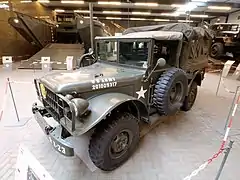

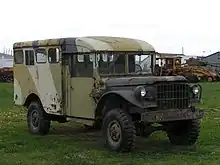
- M42 command truck
- M43 ambulance
- M53 cab-chassis
- M56 tool truck, has a bumper-mounted winch
- MB2 Fire and Rescue Truck (M56 with Gichner body)
- R2 air field rescue truck (w/winch)
- M152 modified enclosed utility truck, Canadian variant
- M201 / V41 telephone maintenance vehicle
- M283 Long Wheel Base (LWB) Cargo Truck
- M506 truck, hydrogen peroxide servicer, PGM-11 Redstone
- V126 truck – for AN/MPX-7 radar
experimental:
- XM142 experimental bomb service truck
- XM152 experimental enclosed utility truck used in small numbers by the USAF
- XM195 experimental lighter, compact version of M37
- XM708 experimental dump truck used mostly by airborne units
- XM711 experimental wrecker truck
Specifications
Engine
The powerplant was identical to the World War II era WC vehicles line, as was most of the drivetrain. The Chrysler Straight-6 cylinder engine was derived from a 1930s era passenger vehicle engine that was widely produced. This was in line with a long-standing military procurement strategy that attempted to use commercially produced vehicle variants in military service.
Many deficiencies with aging design became apparent in the 1960s, including a tendency of the connecting rods to fail at high rpms due to the long cylinder stroke of the engine. As the average speed of the vehicles in the military increased, these engine failures became commonplace due to the low gear ratio of the vehicle, which was originally designed as a multipurpose vehicle capable of transporting heavy loads of ammunition.
- Model: T245 Dodge
- Type: "L" Head, 6 cylinder
- Power: 78 bhp (58.2 kW) at 3200 rpm
- Displacement: 230 cubic inches (3.8 L) (Canadian version used the larger 250.6 cu in (4.1 L) engine)
- Bore: 3+1⁄4 in (82.6 mm), Stroke: 4+5⁄8 in (117 mm)
- Oil capacity: 6 U.S. quarts (5.7 L)
- Radiator capacity: 25 U.S. quarts (24 L)
- Carter carburetor Model ETW-1 downdraft

Driveline
Clutch
- Borg & Beck Model 11828 10 in (250 mm) single plate dry disc (Borg & Beck 11 inch clutch on Canadian version.)
Transmission
- New Process Model 88950 (or NP420)(Acme Model T-98 on Canadian version)
- 4-speed, Synchro-Shift in 3rd and 4th gear
Transfer Case
- New Process 88845 (or NP200)
- Ratio: High 1:1, low 1.96:1
- Twin lever operation, one for 4×4 or 4×2 selection, one for hi or low range
Drive Shaft
- MFG Universal Products
Axles
- Dodge Full Floating (hypoid), ratio 5.83:1
- Front Universal Drive New Process (Tracta joint)
Chassis
Fuel tank
- 24 U.S. gallons (91 L; 20 imp gal) tank (vented through engine air intake for fording purposes)
Electrical
- Ignition, starting, lights, 24 volts
Brakes
- Wagner hydraulic drum
- Parking—external contracting band, 48 square inches (310 cm2)
Steering
- Gemmer Model B-60, worm and sector type
Wheelbase
- Cargo Model M37 and Command Model M42: 112 in (2.8 m)
- Ambulance Model M43 and Tele. Maint. Model V41: 126 in (3.2 m)
Weight
- M37 without winch: 5,687 lb (2,580 kg), M37 with winch 5,987 lb (2,716 kg)
Tire Size
- 9.00 × 16 - 8 ply non-directional military
Winch
- Braden LU-4, PTO operated, 7,500 lb (3,400 kg) capacity (250’ of 7/16" wire rope [75 m by 11 mm] – 10’ [3 m] chain with hook)
Replacement program
During the late 1960s a competition was initiated by the Army, which requested the leading U.S. automotive companies to submit proposals as a replacement for the M37. Several prototype vehicles passed through the preliminary examination, eventually leading the military to accept General Motors XM705 11⁄4-ton Truck and derivative XM737 Ambulance, which were supposed to replace the M37, instead of the militarized COTS M715 series of trucks. However, Congress cut funds for the program, and the XM705 never reached the assembly line.[4]
Below table lists the comparative specifications of the vehicles involved.[5]
| Vehicle | XM705 | M715 | M37 | ||
|---|---|---|---|---|---|
| Engine | Chevrolet 8-307 | Kaiser Jeep 6-230 | Chrysler T-245 | ||
| Maximum horsepower | 200 at 4,600 rpm | 132.5 at 4,600 rpm | 94 at 3,400 rpm | ||
| Net brake horsepower | 140 at 4.000 rpm | 116 at 4,000 rpm | 79 at 3,400 rpm | ||
| Speed (miles per hour) on 31⁄2 percent slope with towed load in 4th gear | 41 | 0 | 0 | ||
| Cruising range (miles) | 300 | 225 | 122 | ||
| Weight distribution (percent) | Front | 44 | 36 | 42 | |
| Rear | 56 | 64 | 58 | ||
| Ground pressure (maximum) | 128 | 16.1 | 12.75 | ||
| Ground clearance under axles (inches) | 11.8 | 10 | 10.75 | ||
| Angle (degrees) of | Approach | With winch | 61 | 33 | 38 |
| Without winch | 61 | 45 | 44 | ||
| Departure | 45 | 25 | 32 | ||
Gallery
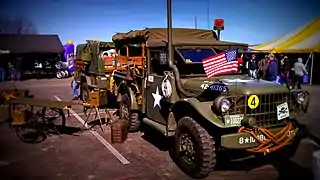 1953 M37 and 1953 M101 trailer[6]
1953 M37 and 1953 M101 trailer[6]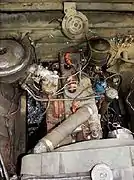 1953 straight six
1953 straight six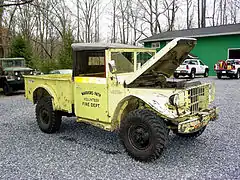 1953 M37
1953 M37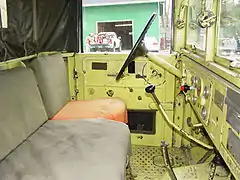 Interior of 1953 M37
Interior of 1953 M37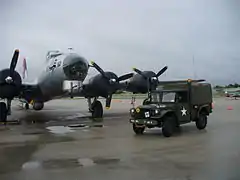 M37 in front of a B-17G operated by the Experimental Aircraft Association.[7]
M37 in front of a B-17G operated by the Experimental Aircraft Association.[7]
See also
References
- ↑ TM-9-2320-212-10 Operator's Manual for M37 series trucks (PDF). Headquarters, Department of the Army. 30 November 1973. Retrieved 30 August 2015.
{{cite book}}:|work=ignored (help) - ↑ creinemann. "1953 M37 Dodge Restoration". Archived from the original on 20 March 2012. Retrieved 16 May 2012.
- ↑ M-715 Kaiser 5/4 Jeep – Olive-Drab
- ↑ Accessed 20 October, 2021 http://www.vintagemilitarytrucks.com/XM705_M705_Chevrolet_4x4_Military-Trucks_Page.htm
- ↑ Statement of Maj. Gen. Henry A. Miley, Jr., Assistant Deputy Chief of Staff, United States Army, Department of Defense Appropriations for 1970, pt.3, pp. 146-148.
- ↑ Reinemann, Carl http://m37.crwdesigns.com/ Archived 15 July 2007 at the Wayback Machine
- ↑ Reinemann, Carl http://dodgem37.com/ Archived 15 July 2007 at the Wayback Machine
- Crismon, Fred W. (2001). US Military Wheeled Vehicles (3 ed.). Victory WWII Publications. pp. 243–245. ISBN 0-970056-71-0.
- Doyle, David (2003). Standard catalog of U.S. Military Vehicles. Krause Publications. pp. 62–69. ISBN 0-87349-508-X.
- TM 9-2320-212-10 M37 Series Operator's Manual. US Dept. of the Army. 1973.
- TM 9-2800 Military Vehicles. US Dept. of the Army. February 1953. pp. 169, 172, 174. Retrieved 1 December 2014.
- Reinemann, Carl. "Dodge M37 History, Restoration, Documentation". Retrieved 26 July 2007.